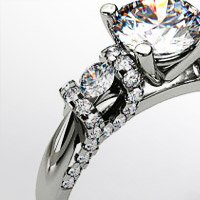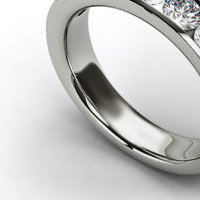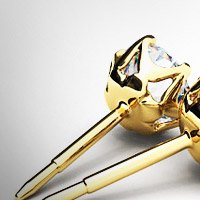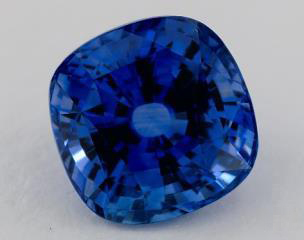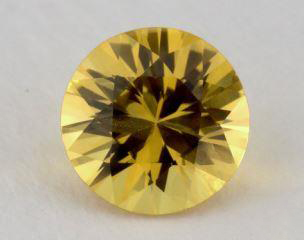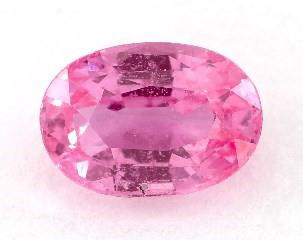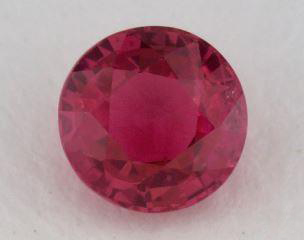Blue Sapphires
Blue sapphire is considered a primary color gemstone; the purer the primary hue, the more valuable the gemstone. Blue sapphires are colored by trace amounts of titanium and iron. (By increasing the level of titanium and iron the color saturation is also increased.) The most common secondary hues found in blue sapphires are purple, violet, and green. Violet and purple can contribute to the overall beauty of the color, while green is considered to be the bane of a blue sapphire. The problem is that all blue sapphires will have a greenish component when viewed at the right angle. It is the cutter that makes sure that the green is not part of the face up position in a sapphire. When gray is included in the overall color of the gemstone, often referred to as a gray mask, the sapphire will have a cool or steely quality as opposed to the normal warm velvety hue of a sapphire. Gray is the normal saturation modifier or mask found in blue sapphires and will often mix with green.
Blue sapphires that are eye-clean or entirely free of inclusions are uncommon, especially in larger sizes. However, blue sapphires with some internal inclusions are still highly valued, as long as the inclusions do not reduce brilliance, obscure color, or otherwise detract from the gemstone’s beauty. Blue sapphires of one-carat weight or more are not usually cut to calibrated sizes or standard shapes. Each gemstone is shaped to maximize the color and weight of the gemstone.
In blue sapphires, cutting can influence color in surprising ways. Sapphires are dichroic gemstone, meaning their color varies depending on the angle from which it is viewed. Viewed in one direction, most blue sapphires appear blue to violet-blue. From another direction, they will appear slightly greenish blue. A skilled cutter will orient their gemstone so that the blue to violet-blue color shows through the finished gem’s crown.
Silk inclusions are also acceptable in blue sapphires, as long as they are not so dense as to compromise color or brilliance. In fact, silk inclusions can increase the value of a sapphire. The heat treatments used to alter color and clarity in blue sapphires break down rutile silk, so the presence of intact silk indicates that a sapphire is unheated. Certain other solid and liquid inclusions burst or deform under extreme heat and are also useful indicators of heat treatment.
Heat treatment and diffusion make attractive blue sapphires out of common corundum that would have little or no value without treatment. Heat treatment is widely used in the international sapphire market, and it is estimated that well over 90 percent of all blue sapphire in the market today has been subject to heat treatment. Diffusion treatment is far more controversial, and diffusion-treated blue sapphires sell for much less than those which have only been heat-treated.
Blue sapphires are found in a number of locations around the world including Kashmir, Myanmar, Sri Lanka, Madagascar, Thailand, Australia, Tanzania, and the state of Montana in the United States.
Yellow Sapphires
After blue sapphires, yellow sapphires are the most sought after color in today’s jewelry industry. Many yellow sapphires are thought to closely resemble yellow diamonds. They can range in color from bright canary yellow to greenish yellow, to everything in between. While customers tend to prefer a yellow sapphire color that is a medium, vibrant canary yellow, a deep, orangish yellow (whisky color), is highly valued in some Asian markets.
The most common cause of the yellow coloration in a sapphire is the trace element iron. Typically speaking, increased iron concentrations will also increase color saturation. Yellow sapphires can also be colored naturally by low-level radiation within the earth or by lab-induced irradiation. Gemstones that obtain their color through irradiation have been known to fade with exposure to heat and light. Heat treatments have vastly increased the supply of yellow sapphires on the market today. Unheated yellow sapphires with strong saturation remain quite rare.
Yellow sapphires frequently have fewer inclusions than other sapphire colors, and are held to higher clarity’s than other sapphire colors. The trace element titanium may cause an undesirable green cast in yellow sapphires, which makes the most valuable gemstone those that are relatively titanium-free. (The titanium-bearing rutile silk is less common in fine yellow sapphires than sapphires of other colors.) Yellow sapphire’s transparency and clarity is paramount to the value of the sapphire.
Yellow sapphire rough has traditionally been less costly than blue, pink, or Padparadscha (a mixture of pink and orange), so cutters are more reluctant to compromise brilliance in favor of weight retention. As a result, well-cut yellow sapphires are easier to find than other sapphire colors. (Yellow sapphires are also more likely to be available in specialty cuts such as radiant cuts which enhance the color of the gemstone.)
Yellow sapphires are found in Tanzania, Madagascar, Thailand and Australia, although Sri Lanka is the primary source.
Pink Sapphires
Pink sapphires come in very pale pastel pinks to vibrant and intense hot pinks. Pink sapphires are colored by traces of chromium. Lower concentrations of chromium create pink sapphires while very high chromium concentrations will create a ruby. If the trace element titanium is included in the crystal structure, the sapphire will have a more purplish pink hue.
Because pink sapphires are rare, gemstones half a carat or more are not cut into calibrated sizes. Instead, each gemstone will be cut to retain as much of the gemstone as possible. A mixed cut will enhance the beauty of the color and retain the weight of the gemstone. Customers will find that the most common shapes are cushions or ovals. Eye-clean, untreated gemstones are available on the market, but the majority of pink sapphires have had their clarity enhanced by heat treatment.
Many of the sapphires from Madagascar are subjected to moderate heat treatments to reduce their purplish secondary colors. Moderate heat treatments are very different from the traditional long duration, high temperature heating of blue and yellow sapphires. Madagascar pink sapphires, on the other hand, are heated at temperatures far lower and are considered more gentle (about 400º C) for only a few hours. This process does not alter the internal characteristics of the gemstone while high heat temperatures will affect the inclusions drastically.
Green Emeralds
Recently chosen as Pantone “Color of the Year” for 2013; emeralds are among the most precious of natural gemstones, alongside rubies, sapphires and diamonds. Emerald is a type of the mineral beryl. Its green color is a result of small amounts chromium and sometimes vanadium within the gemstone. Depending on the amount of these elements, the emerald can appear light green to a very deep, dark green. Emeralds are by far the most stunning and popular of the green color gemstones. For centuries, they have been among the most sought after and valuable gemstones symbolizing rebirth and love.
Color
The color of a gemstone is considered to be the most defining characteristic when evaluating the overall appearance. Color is the most important factor when pricing emeralds and is broken down into three components: hue, saturation and tone. An ideal emerald for an engagement ring is well saturated and bright.
Emeralds are found in hues ranging from yellow-green to blue-green, with the primary hue being green. The most desirable emerald colors are bluish green to green, with vivid saturation and medium to medium dark tone. The most prized emeralds are highly transparent with even color distribution and no eye visible color zoning. Secondary hues found in emeralds are usually yellow and blue however, when the hue is too yellowish or bluish the stone is no longer considered an emerald but will be considered a different beryl. (Gray is the saturation modifier or mask found in emeralds.)
Beryl is a relatively common mineral and is associated with many gemstones. For instance, beryl that is yellow or orange is usually called Heliodor, pink or salmon colored beryl is called Morganite and the rarest type of beryl, bixbite is a deep, intense red. Emerald usually comes in a deep, intense green. However, it is sometimes found as a light green or even to have a tinge of yellow in the stone.
Clarity
Emerald tends to have numerous inclusions and surface breaking fissures. Unlike a diamond, where the loupe standard, i.e. 10X magnification, is used to grade clarity, emerald is graded by eye. Thus, if an emerald has no visible inclusions to the eye (assuming normal visual acuity) it is considered flawless. Stones that lack surface breaking fissures are extremely rare and therefore almost all emeralds are treated, "oiled", to enhance the apparent clarity. The most expensive emeralds are eye-clean stones of an intense primary green hue with no more than 15% of any secondary hue or combination of a medium-dark tone.
Red Rubies
While rubies are universally accepted as red corundum, there are differing opinions on what constitutes a ruby versus a pink sapphire. Rubies receive their red color from high levels of the trace element chromium just as a pink sapphire has traces of chromium. It is the saturation that defines the category in which the corundum falls. In some Asian markets, rubies with traces of pink are acceptable while in the European and North American markets, red and pink corundum is often delegated into two separate color categories.
Color is by far, the most important to consider when evaluating a Ruby, with transparency being the secondary concern. Objective color determination has been difficult to achieve for rubies. Ancient trade terms such as “pigeon’s blood,” “pomegranate,” “saffron,” and “China rose” have long been used to describe the color of a ruby. However, these terms are not universally recognized and an objective system for evaluating rubies did not exist until recently.
The lines between the color boundaries of pink and red are often blurred. In the case of rubies, the ideal color is a vivid, medium-dark red to slightly purplish red with a medium to medium-dark tone and either strong or vivid saturation. Many fine rubies from Myanmar have a slight purple secondary color while Thai rubies have been said to exhibit a “garnet red” color due to their dark tone. If the ruby can fluoresce, that attribute can intensify the gemstone’s color while rutile needles have the ability to reflect light and also heighten the color.
A ruby’s unique ability to fluoresce is sometimes used in determining its origin as well as proving that a ruby is indeed a ruby. Burmese rubies, which are often formed in marble, tend to have fluorescence while Thai and Cambodian rubies, which form within basaltic, (iron-rich rocks) do not fluoresce.
Like sapphires, rubies are not subject to the same clarity expectations as diamonds. Natural rubies and sapphires are far rarer and are not graded at 10x magnification. Rather, they are graded and viewed on eye level; a high clarity ruby would be considered "eye clean."
The most famous ruby sources are Myanmar (Burma) and Sri Lanka (Ceylon). However, Vietnam and Thailand, in Afghanistan, Africa, Cambodia, India, Kashmir, Laos, Nepal, Pakistan, Tajikistan and the United States (North Carolina) are also notable resources
Myanmar, formerly known as Burma, has been a key source of the highest quality rubies for centuries. The illustrious Burmese ruby will have the perfect combination of intense color, silk, and strong fluorescence.
Rubies from Myanmar are mainly found in two locations: the famous Mogôk Valley, and Möng Hsu. While exact dates are hard to come by, it is believed that the Mogôk Valley has been a source of rubies for almost a thousand years. The Möng Hsu area was only recently developed in the 1990s. In 2008 Congress passed an act that banned the importation of Burmese jade and ruby into the United States. Prices for Burmese rubies are at a premium as the number of gemstone for sale is limited to items imported before the act.
Sri Lanka has a long history with gemstone formations and throughout history has been dubbed “Island of Gems.” Sri Lankan rubies tend to be more brilliant, lighter in color tones that contain pink or purple secondary colors, as well as higher clarity than rubies from other locations. Other characteristics include a strong fluorescence, color zoning, and the presence of silk.
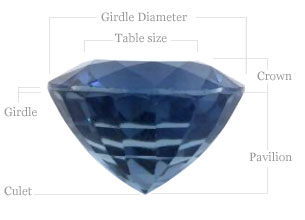
Gemstone Anatomy
Clarity
In natural gemstones, clarity refers to the amount of internal flaws (inclusions) or external flaws of each stone. Most gemstones have some amount of inclusions, and finding a flawless gemstone is rarer than finding a flawless diamond. When natural gemstones are formed, the process within the earth that creates them is what determines the number of flaws a cut stone will have. Some gemstones, like the emerald, are formed under violent circumstances, and, therefore, are almost always included. Darker gemstones-like the blue topaz, purple amethyst, and red garnet-can carry more inclusions without lessening the value because the depth of their color masks most flaws. Lighter gemstones will show internal inclusions much more clearly. The diamond is the most obvious example, although it is less common to find an internally flawless emerald than an internally flawless diamond. Sapphires rarely exhibit the high clarity of fine diamonds. Sapphires host many different inclusions, and even the best sapphires are not expected to be free of inclusions when viewed at 10x magnification. In fact, sapphire inclusions vary with their source or origin and treatment history.
Where clarity is concerned, colored gemstone are divided into several classifications reflecting differences in the geological conditions under which they are formed and how those conditions affect the physical appearance of the gemstone, with and without magnification. Colored gemstones are basically divided into three categories by GIA for purposes grading clarity; Type I, Type II and Type III.
Type I – Gemstone form under geological conditions in which inclusions are not very noticeable and such gemstone are often "eye-clean."
Type II – Gemstone form under geological conditions that are more severe, resulting in the presence of inclusions that are typically more noticeable. Sapphires fall into Type II gemstone.
Type III – Gemstone form under the most violent geological conditions, resulting in gemstone that typically show inclusions, often to the unaided eye, and are rarely "eye-clean."
Cut
Colored gemstones come in all sorts of shapes and cuts that are designed to enhance their natural beauty; the best cuts enhance and reflect light in an even manner without any darkness or windowing in the stone. There are no fixed rules for cutting colored gemstones, and often the cutter makes a choice based on the inclusions in the gemstone in order to work best around any such flaws so as to minimize their impact.
The facets on the top or crown of the gem have the function of capturing light, while the facets on the bottom or pavilion reflect light internally. This capturing and reflecting light produces several different visual effects.
Polish
Gemstones are polished to give a reflective finish, in order to allow light to refract through the stone and reflect off the surface. A variety of materials can be used to polish a gemstone, including very fine diamond grades, metal oxides, like aluminum oxide or ferric oxide, or felt, leather or wood. A gemstone’s polish is largely connected to its sparkle.

